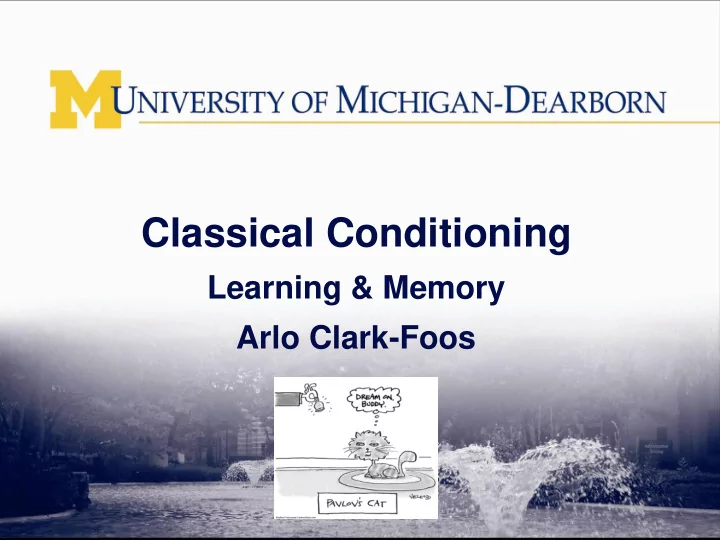

Classical Conditioning Learning & Memory Arlo Clark-Foos
What is classical conditioning? • Learning to associate previously neutral stimuli with the subsequent events. • Howard Eichenbaum’s Thanksgiving Pavlov’s psychic secretion
Are you conditioned? • Some examples of every day conditioning… – Holiday Traditions – Food Associations – Fears – Superstitions – Habits – Skills?
Ivan Pavlov • How are digestive fluids controlled? – Historical view – Pavlov’s view – Pavlov’s Original Experiment
Pavlov’s Experiments • Psychic Secretion – Specialized procedure for introducing food • Claude Bernard’s psychic secretion in horses – Pavlov’s psychic secretion was unreliable but… Pavlov Museum, Ryazan, Russia
Stimuli and Responses This is appetitive conditioning. What is an example of aversive conditioning?
Conditioned Emotional Response Estes & Skinner Appetitive (Dudai, Jan, Byers, Quinn, & (Domjan, Lyons, North, & Benzer, 1976) Bruell, 1986)
Slapping and Blinking in the Name of Research Clark Hull Ernest Hilgard Photo Sensors Electromyography (EMG) Very well studied
Rabbit Eyeblink Conditioning reactive predictive
It gets more complicated… • Similarity among species • Tolerance, compensatory responses, and homeostasis • Stimulus Timing and Presentation – Contemporaneous Presentation • Not spaced too far apart in time – Is there an ideal spacing? – Order and Consistency • Reliable relationship/expectation
Conditioning Procedures Interstimulus Intertrial Interval Interval Conditioning Forward
Learning Not to Respond Conditioned Inhibition: Decrease in CR in response to CS. – Need Baseline CRs diminish CS+ 1(Tone) US CS 1 ? CS 1 + CS 2 over time as CS- CS- 2(Light) CS 2 ? inhibits CS+ Baseline
Transfer of Learning • Generalization CS 800mHz CR CS 1200mHz Max CR CS (Tone,1200mHz) US CS 1600mHz CR • Discrimination CS (Tone,300mHz) CS 300mHz CS (Tone,500mHz) US CS 500mHz CR CS (Tone,800mHz) CS 800mHz
Context as CS • Penick & Solomon (1991) – Eyeblink conditioning in rats – Hippocampal Lesions Transfer Appropriate Processing & Encoding Specificity
What is being conditioned? • How is it learned and what is the nature of the association?
S-S or S-R Association? • Stimulus Substitution Theory (Pavlov) – Definition (S-R Association) – US, CS, and Response centers in the brain US Response S-S Association CS S-R Association – Problem: a CR is not a UR • CR eyeblink is often more gradual and less complete
Rescorla (1973) US Devaluation Conditioned Habituate Noise Suppression Lever Reward Lever + Light? (Light/CS + Loud Noise/US) US Response Less CR after US devaluation. S-S Association CS S-R S-S Association Association
After Conditioning • After learning, what happens when you present the CS alone? Extinction
What happens in extinction? • What do we (researchers) see? – No CR = Forgetting? – Excitatory and Inhibitory Associations (Pavlov) • CC • Extinction Human eyeblink conditioning and the reduction in responses during extinction.
Extinction = Forgetting? • Spontaneous Recovery – Pavlov: Inhibitory connections are weak, fade – Alt. Theory: Attention/Interest in CS (habituation?) Human eyeblink conditioning and the reduction in responses during extinction.
Extinction = Forgetting? • Disinhibition – Surprising, typically arousing, new stimulus – Return of CR (akin to sensitization) • Rapid Reacquisition – Retraining vs. Original Conditioning – Something is retained Extinction is NOT Forgetting
Compound Conditioning • Context, Multiple Cues – Extinction: “respond” and “don’t respond” • Overshadowing – Salience
Error Correction • Problems with Aristotle’s contiguity • Informational value of cues • Kamin’s (1969) Compound conditioning
Rescorla-Wagner (1972) • Learning on Trains – Contiguity is not enough • Competition for associative strength • Prediction Error – Positive vs. Negative prediction errors – Error-correction learning
R-W in Humans • Error Correction in Human Category Learning – Bower & Trabasso, 1964 • Informational value of dot
Modelling Conditioning • Associative Weights – Connectionist Models (e.g., McClelland & Rumelhart)
Pay Attention! • Exposure to CS alone retards later learning – Attention to stimuli – Latent inhibition • Lubow & Moore (1959) – Sheep and Goats • Where is the surprise? – US Modulation Theory • Prediction error (Rescorla & Wagner, 1972) – CS Modulation Theory • Attention to stimuli (Mackintosh, 1975)
Properties of C Conditioning • It takes time – 4-5 mo., no eyeblink conditioning in first block but exposure necessary for later learning. • Other Factors – Intensity of CS-US – Timing, ISI Ivkovich et al., 1999
Intensity of CS-US • Faster and More effective US Intensity Maintained US Intensity Decreased
Timing, ISI • Timing is critical! – Ideal ISI for rapid learning – Humans = Animals Pavlov observed no CRs with Backward Conditioning: CS does not predict US. Animals must be learning association AND temporal contiguity
Taste Aversion (Garcia Effect) • Temporal Contiguity – Food poisoning after a date… • Belongingness : CS-US pairings. – Tone + Food Shock or Poison – (Garcia & Koelling, 1966) • Neurological basis: gustatory cortex • Coyotes (Gustavson et al., 1974)
Neural Basis in Mammals • Cerebellum – Purkinje cells • Inhibitory connection to interpositus nucleus – Interpositus nucleus • CR output pathway • Error correction • Brain Stem – Pontine nuclei (CS) • Specialized sensory processing – Inferior Olive (US) • Activates interpositus nucleus and Purkinje cells
Neural Bases of CC A simpler diagram of Rabbit eyeblink conditioning
Cerebellum • Electrical activity Purkinje cells • Stimulating the inferior olive – Even specific tones, lights, etc. – Substitute for actual US • CC impaired after damage
CS Modulation • Latent inhibition not explained by RW • Mackintosh (1975) – Salience of Sensory cues – Hippocampus • Animals without do NOT show latent inhibition
Back to Aplysia
CC in Aplysia 1. Aplysia and Eric Kandel
Neural Bases of CC In the long run, it’s all just LTP
Proteins • Two routes to long lasting memory – Activate CREB-1 • Synaptic growth – Deactivate CREB-2 • Rapid learning
Addiction and Tolerance • Homeostasis and compensatory responses – Environmental cues as CS • Reducing reliance on drugs? + +
Recommend
More recommend